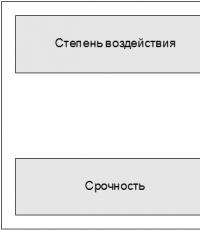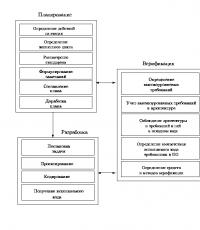What does the group number correspond to in the periodic table? Periodic system of D. I. Mendeleev. Electronic structure of noble gases
Periodic table group chemical elements a sequence of atoms in increasing nuclear charge that have the same electronic structure. The group number is determined by the number of electrons on the outer shell of the atom (valence electrons) ... Wikipedia
The fourth period of the periodic system includes elements of the fourth row (or fourth period) of the periodic system of chemical elements. The structure of the periodic table is based on rows to illustrate repeating (periodic) ... ... Wikipedia
The first period of the periodic system includes elements of the first row (or first period) of the periodic system of chemical elements. The structure of the periodic table is based on rows to illustrate repeating (periodic) trends in... ... Wikipedia
The second period of the periodic system includes elements of the second row (or second period) of the periodic system of chemical elements. The structure of the periodic table is based on rows to illustrate repeating (periodic) trends in ... Wikipedia
The fifth period of the periodic system includes elements of the fifth row (or fifth period) of the periodic system of chemical elements. The structure of the periodic table is based on rows to illustrate repeating (periodic) trends in... ... Wikipedia
The third period of the periodic system includes elements of the third row (or third period) of the periodic system of chemical elements. The structure of the periodic table is based on rows to illustrate repeating (periodic) trends... Wikipedia
The seventh period of the periodic system includes elements of the seventh row (or seventh period) of the periodic system of chemical elements. The structure of the periodic table is based on rows to illustrate repeating (periodic) trends... Wikipedia
The sixth period of the periodic system includes elements of the sixth row (or sixth period) of the periodic system of chemical elements. The structure of the periodic table is based on rows to illustrate repeating (periodic) trends in... ... Wikipedia
The short form of the periodic table is based on the parallelism of oxidation states of elements of the main and minor subgroups: for example, the maximum oxidation state of vanadium is +5, like phosphorus and arsenic, the maximum oxidation state of chromium is +6 ... Wikipedia
The "Grouping" request is redirected here. A separate article is needed on this topic... Wikipedia
Consists of vertical rows (groups) and horizontal rows (periods). To better understand the principles of combining elements into groups and periods, let's consider several elements, say, the first, fourth and seventh groups.
From the above electronic configurations it is clear that the outer (highest in energy) electron shells of atoms of the same group are filled with electrons equally. Elements located in the same vertical column of the table belong to one group. Group IVA elements of the periodic table have two electrons in the s orbital and two electrons in the p orbital. The configuration of the outer electron shell of fluorine F, chlorine Cl and bromine Br atoms is also the same (two s and five p electrons). And these elements belong to one group (VIIA). Atoms of elements of the same group have the same structure of the outer electron shell. That is why such elements have similar chemical properties. The chemical properties of each element are determined by the electronic structure of the atoms of this element . This fundamental principle modern chemistry. It is this that underlies the periodic table.
The group number of the periodic table corresponds to the number of electrons in the outer electron shell
atoms of elements of this group. The number of the period (horizontal row of the periodic table) coincides with the number of the highest occupied electron orbital. For example, sodium and chlorine are both elements of the 3rd period and both types of atoms have the highest, electron-filled level - the third. 
Strictly speaking, the number of electrons in the outer electron shell determines the group number only for the so-called non-transition elements located in groups with the letter index A.
Electronic structure atoms determines the chemical and physical properties of elements. And since the electronic structure of atoms repeats itself after a period, the properties of the elements also repeat periodically.
The periodic law of D. I. Mendeleev has the following formulation: “the properties of chemical elements, as well as the forms and properties of the simple substances and compounds they form, periodically depend on the magnitude of the charges of the nuclei of their atoms”.
Atomic sizes
We should dwell on two more types of information obtained from the periodic table. The first of these is the question of the size (radius) of atoms. If you move down within a given group, moving to each next element means filling the next one with electrons, more and more high level. In group IA, the outer electron of the sodium atom is in the 3s orbital, potassium is in the 4s orbital, rubidium is in the 5s orbital, etc. Since the 4s orbital is larger in size than the 3s orbital, the potassium atom is larger in size than sodium atom. For the same reason in each group the sizes of atoms increase from top to bottom .
As you move to the right through a period, atomic masses increase, but the sizes of atoms, as a rule, decrease. In the 2nd period, for example, the neon Ne atom is smaller in size than the fluorine atom, which, in turn, is smaller than the oxygen atom.

Electronegativity
Another trend revealed by the periodic table is the natural change in the electronegativity of elements, that is, the relative ability of atoms to attract electrons that form bonds with other atoms. For example, noble gas atoms do not tend to gain or lose electrons, while metal atoms readily give up electrons, and non-metal atoms readily accept them. Electronegativity (the ability to attract, acquire electrons) increases from left to right within a period and from bottom to top within a group. The last group (inert gases) falls outside of these patterns.
Fluorine F, located in the upper right corner of the periodic table, is the most electronegative element, and francium Fr, located in the lower left corner, is the least electronegative. The change in electronegativity is also shown by arrows in the figure.  Using this regularity, one can, for example, assert that oxygen is a more electronegative element than carbon or sulfur. This means that oxygen atoms attract electrons more strongly than carbon and sulfur atoms.
Using this regularity, one can, for example, assert that oxygen is a more electronegative element than carbon or sulfur. This means that oxygen atoms attract electrons more strongly than carbon and sulfur atoms.
Pauling's first and widely known scale of relative atomic electronegativities ranges from 0.7 for francium atoms to 4.0 for fluorine atoms. 
Electronic structure of noble gases
 The elements of the last group of the periodic table are called inert (noble) gases. In the atoms of these elements, except for helium He, there are eight electrons in the outer electron shell. Noble gases do not enter into chemical reactions and do not form any compounds with other elements (except for very few exceptions). This is because the configuration of eight electrons in the outer electron shell is extremely stable.
The elements of the last group of the periodic table are called inert (noble) gases. In the atoms of these elements, except for helium He, there are eight electrons in the outer electron shell. Noble gases do not enter into chemical reactions and do not form any compounds with other elements (except for very few exceptions). This is because the configuration of eight electrons in the outer electron shell is extremely stable.
 Atoms of other elements form chemical bonds in such a way that they have eight electrons in their outer shell. This position is often called octet rule
.
Atoms of other elements form chemical bonds in such a way that they have eight electrons in their outer shell. This position is often called octet rule
.
1. The period number in D.I. Mendeleev’s Periodic System corresponds to
1) the number of energy levels in an atom
2) the number of valence electrons in an atom
3) the number of unpaired electrons in an atom
4) the total number of electrons in an atom
2. The number of electrons in the electron shell of an atom is determined
1) number of protons
2) number of neutrons
3) the number of energy levels
4) the value of the relative atomic mass
3. In the series of chemical elements, silicon → phosphorus → sulfur decreases
1) the ability of an atom to accept electrons
2) highest oxidation state
3) lowest oxidation state
4) atomic radius
4. For elements of groups A, the atomic number decreases with increasing
1) atomic radius
2) charge of the atomic nucleus
3) the number of valence electrons in atoms
4) electronegativity
5. In the main subgroups of the Periodic Table of D.I. Mendeleev, from bottom to top, the main properties of metal hydroxides
1) increase
2) decrease
3) do not change
4) change periodically
6. Among the elements of group IVA, the maximum atomic radius is
1) germanium
2) carbon
3) tin
4) silicon
7. The metallic properties of the element are most pronounced
1) Na
2) Mg
3) K
4) Sa
8. The element has less pronounced non-metallic properties than silicon
1) carbon
2) germanium
3) phosphorus
4) nitrogen
9. The strongest base corresponds to the element





